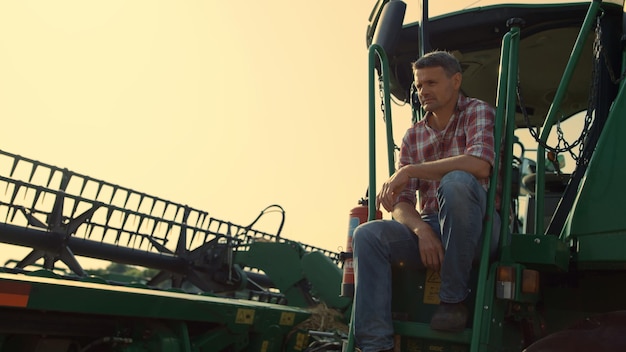Unlock Long-Term Wealth: Investing in Farmland

Investing in farmland presents a unique opportunity to diversify portfolios, offering tangible asset ownership, consistent income potential through leases, and long-term capital appreciation driven by increasing global food demand.
Looking for a stable, long-term investment that’s rooted in something real? Investing in farmland might be the perfect addition to your portfolio. This guide dives into the benefits, risks, and strategies for making smart farmland investments.
Why Consider Investing in Farmland?
Farmland offers a compelling investment opportunity due to its tangible nature and essential role in food production. Unlike stocks or bonds, farmland is a physical asset you can see and touch. Its inherent value is tied to the basic human need for food, making it a relatively stable investment, particularly in times of economic uncertainty.
Several factors contribute to the appeal of farmland as an investment. These include its potential for consistent income generation through leasing, long-term capital appreciation, and its role as a hedge against inflation.
Inflation Hedge and Safe Haven Asset
Farmland has historically acted as a hedge against inflation. As prices for goods and services rise, so too does the value of agricultural commodities, driving up farmland values. Additionally, farmland is often considered a safe haven asset during economic downturns, as demand for food remains relatively constant regardless of market conditions.
- Tangible asset with intrinsic value
- Hedge against inflation
- Historically stable during economic downturns
Income Generation Through Leasing
One of the primary ways to generate income from farmland is through leasing it to farmers. Lease arrangements can vary, ranging from fixed cash rents to crop-sharing agreements. This provides investors with a consistent stream of revenue while the land appreciates in value.

Farmland’s role in the agricultural supply chain makes it a unique asset class with the potential to provide investors with both income and long-term stability.
Understanding the Returns on Farmland Investments
Investing in farmland can generate returns in several ways, including annual income from renting or leasing the land, and appreciation from the sale of the land itself. Understanding both of these components is crucial for evaluating the overall ROI.
While the historical returns on farmland investments are attractive, it’s important to remember that past performance is not necessarily indicative of future results. Factors such as geographic location, soil quality, and commodity prices can significantly influence returns.
Historical Performance of Farmland
Historically, farmland has offered competitive returns compared to other asset classes. The NCREIF Farmland Index, a widely used benchmark for farmland performance, has shown consistent positive returns over the long term. These returns have often outperformed those of stocks, bonds, and real estate.
Investors should carefully consider their individual goals and risk tolerance when assessing the suitability of farmland investments.
- Historical Outperformance: Farmland has provided competitive returns compared to other assets.
- Income Potential: Rental income and crop yields contribute to annual returns.
- Appreciation: Land values can increase over time.
Key Factors Influencing Farmland Returns
Several factors can influence the returns on farmland investments. These include commodity prices, weather patterns, government policies, and interest rates. Understanding these factors can help investors make informed decisions.
For example, rising commodity prices can boost farm income, leading to higher rental rates and increased land values. Favorable weather conditions can also result in better crop yields, further improving profitability.
Careful market research and due diligence can help investors navigate these factors and maximize their returns on farmland investments.
Assessing the Risks of Farmland Investments
Like any investment, farmland comes with its own set of risks. Understanding these risks is crucial for making informed decisions and managing your investment effectively. Factors such as weather, commodity prices, and changing regulations can impact the profitability of your investment.
While farmland is often considered a relatively stable investment, it’s not immune to market volatility. Economic downturns, trade disputes, and other unforeseen events can affect the demand for agricultural products and, consequently, farmland values.
Environmental and Climate Risks
Environmental and climate risks are a significant consideration for farmland investors. Droughts, floods, and other extreme weather events can damage crops and reduce yields, impacting profitability. Soil erosion and water pollution can also degrade farmland over time, affecting its long-term value.
Implementing sustainable farming practices and investing in water conservation measures can help mitigate these risks.
- Weather-Related Risks: Drought, floods, and extreme weather can impact yields.
- Commodity Price Volatility: Fluctuations in agricultural prices can affect farm income.
- Regulatory Changes: Environmental regulations and trade policies can impact profitability.
Land Management and Operational Challenges
Farmland investing requires a hands-on approach to land management. Investors need to ensure that the land is properly maintained, fertilized, and protected from pests and diseases. This can be a time-consuming and labor-intensive process, particularly for absentee owners.

Another challenge is finding qualified tenants or farm managers to operate the land efficiently. A skilled tenant can significantly increase crop yields and improve profitability, while a poor tenant can deplete the soil and damage the land over time.
Thorough due diligence and careful tenant selection are essential for mitigating these risks.
Strategies for Investing in Farmland
There are several ways to invest in farmland, each with its own set of advantages and disadvantages. Some investors prefer to purchase farmland directly, while others opt for indirect investment vehicles such as REITs or farmland funds. Your choice will depend on your individual investment goals, risk tolerance, and available capital.
Direct ownership offers the most control over your investment, but it also requires more time, expertise, and capital. Indirect investment options provide a more passive approach, but they may come with higher fees and less control.
Direct Farmland Ownership
Direct farmland ownership involves purchasing farmland outright. This provides investors with complete control over the land and its operations. It also allows them to benefit directly from any appreciation in land values.
However, direct ownership requires substantial capital and a willingness to actively manage the land or hire a farm manager. It also carries the risk of vacancy and the potential for environmental liabilities.
Careful site selection and a long-term investment horizon are essential for success with direct farmland ownership.
- Complete Control: Direct ownership allows for full control over land management and operations.
- Direct Appreciation: Benefit directly from increases in land value.
- Higher Capital Requirement: Requires significant upfront investment.
Indirect Farmland Investments: REITs and Funds
Indirect farmland investments offer a more accessible and diversified way to participate in the farmland market. These investments typically involve purchasing shares in a real estate investment trust (REIT) or a farmland fund that owns and manages a portfolio of farmland properties.
REITs and funds provide investors with exposure to farmland without the need to directly own or manage the land. They also offer the potential for dividend income and capital appreciation.
However, indirect investments may come with higher fees and less control over the underlying assets.
Due Diligence: Researching Farmland Before Investing
Before investing in farmland, it’s crucial to conduct thorough due diligence to assess the land’s suitability and potential for returns. This involves researching the land’s history, soil quality, water availability, and local market conditions. It also requires understanding the regulatory environment and any potential environmental liabilities.
Failure to conduct proper due diligence can result in costly mistakes and disappointing returns. Investors should work with experienced professionals such as real estate agents, appraisers, and agricultural consultants to gather the necessary information.
Assessing Soil Quality and Water Availability
Soil quality and water availability are critical factors in determining the productivity and value of farmland. Poor soil quality can limit crop yields and increase the need for expensive fertilizers and soil amendments. Insufficient water availability can restrict the types of crops that can be grown and increase the risk of drought damage.
Investors should obtain soil tests and water assessments to evaluate the land’s suitability for various crops. They should also consider the availability of irrigation systems and the potential for water rights disputes.
- Soil Testing: Evaluate soil composition and fertility.
- Water Assessment: Determine water availability and quality.
- Environmental History: Check for any contamination or environmental liabilities.
Evaluating Market Conditions and Location
The location of farmland can significantly impact its value and potential for returns. Farmland located in areas with strong agricultural economies and favorable growing conditions is typically more valuable than land in less desirable areas.
Investors should research local market conditions, including commodity prices, rental rates, and land values. They should also consider the proximity to markets, transportation infrastructure, and agricultural support services.
A well-chosen location can significantly enhance the profitability and long-term value of your farmland investment.
Financing Your Farmland Investment
Financing options play a crucial role in making farmland investments accessible to a wider range of investors. While purchasing farmland outright requires substantial capital, various financing options can help investors leverage their funds and acquire larger or more desirable properties. These options range from traditional bank loans to government-backed programs designed to support agricultural development.
Understanding the nuances of each financing avenue is key to securing the best terms and maximizing your investment potential. Whether you’re a seasoned investor or new to the market, exploring these options can significantly impact your ability to successfully invest in farmland.
Traditional Agricultural Loans
Traditional agricultural loans are a common financing option for farmland investments. These loans are typically offered by banks and other financial institutions and are specifically tailored to the needs of farmers and agricultural businesses. They often come with competitive interest rates and flexible repayment terms to accommodate the cyclical nature of farming.
However, securing a traditional agricultural loan may require a strong credit history, a comprehensive business plan, and significant collateral. Lenders will also typically assess the borrower’s experience in farming and their ability to manage the land effectively.
- Competitive Interest Rates: Often lower than other types of loans.
- Flexible Repayment Terms: Designed to align with farming cycles.
- Collateral Required: Typically includes the land itself.
Government-Backed Loan Programs
Several government-backed loan programs are available to support farmland investments. These programs are typically offered through agencies such as the Farm Service Agency (FSA) and the USDA. They often come with more favorable terms than traditional loans, such as lower interest rates and longer repayment periods.
Eligibility requirements for government-backed loan programs vary depending on the specific program. However, they typically target beginning farmers, underserved populations, and those who are committed to sustainable farming practices.
Exploring government-backed loan programs can be a valuable option for investors seeking to reduce their financing costs and access more favorable terms.
| Key Point | Brief Description |
|---|---|
| 🌱 Tangible Asset | Farmland provides ownership of a physical, essential asset. |
| 💰 Income Potential | Generate income through leasing to farmers. |
| 📈 Long-Term Growth | Land values can appreciate over time. |
| 🛡️ Inflation Hedge | Farmland often retains value during inflationary periods. |
Frequently Asked Questions
▼
Farmland offers tangible asset ownership, consistent income through leases, potential capital appreciation, and can serve as a hedge against inflation.
▼
Risks include weather-related events affecting crop yields, fluctuating commodity prices, environmental regulations, and land management challenges.
▼
You can invest directly by purchasing land, or indirectly through REITs and farmland funds, offering varied levels of control and capital requirements.
▼
Assess soil quality, water availability, market conditions, location, and any environmental liabilities to make an informed investment decision.
▼
Options include traditional agricultural loans from banks, and government-backed programs offering more favorable terms to support farmers and investors.
Conclusion
Investing in farmland presents a compelling opportunity for long-term wealth creation and portfolio diversification. By understanding the benefits, risks, and strategies outlined in this guide, you can make informed decisions and cultivate a successful farmland investment.





